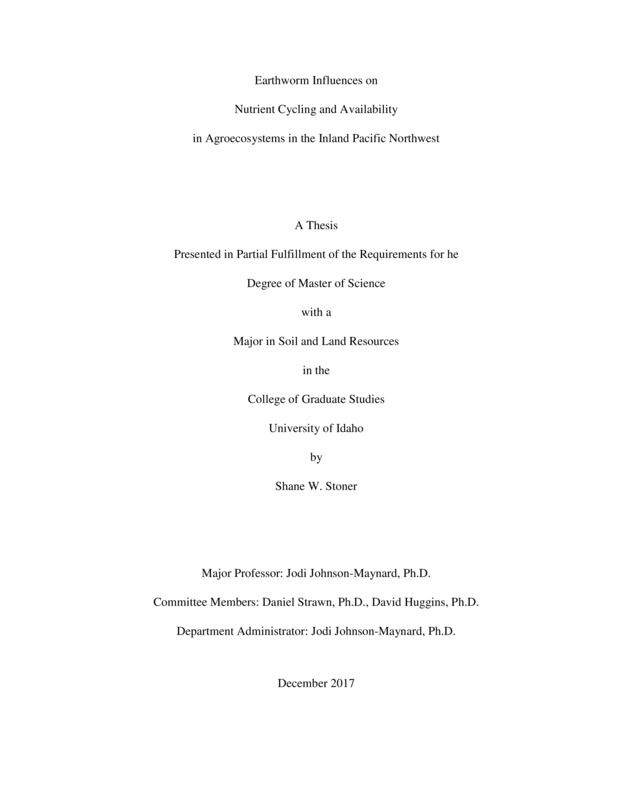Earthworm Influences on Nutrient Cycling and Availability in Agroecosystems in the Inland Pacific Northwest
Stoner, Shane Wesley. (2017-12). Earthworm Influences on Nutrient Cycling and Availability in Agroecosystems in the Inland Pacific Northwest. Theses and Dissertations Collection, University of Idaho Library Digital Collections. https://www.lib.uidaho.edu/digital/etd/items/stoner_idaho_0089n_11279.html
- Title:
- Earthworm Influences on Nutrient Cycling and Availability in Agroecosystems in the Inland Pacific Northwest
- Author:
- Stoner, Shane Wesley
- ORCID:
- 0000-0003-4358-8054
- Date:
- 2017-12
- Keywords:
- drilosphere earthworms Inland Pacific Northwest isotopes Lumbricus terrestris Palouse
- Program:
- Plant, Soil and Entomological Sciences
- Subject Category:
- Soil sciences
- Abstract:
-
Earthworm population density has increased in no-till agroecosystems in the Inland Pacific Northwest (IPNW) cereal production region, but the overall impact of this increase on agricultural production is unknown. A field study was conducted to identify nutrient concentrations and gradients with distance from Lumbricus terrestris earthworm burrows in agroecosystems. Total carbon (C), nitrogen (N), ammonium (NH4+-N) calcium (Ca), and phosphorus (P) concentrations were greatest in drilosphere soil immediately surrounding burrows, with concentrations generally decreasing as distance from burrow walls increased. Despite large variability, weak trends toward greater nutrient concentrations were observed in active earthworm drilosphere soil compared to abandoned burrows with significant root colonization.
A 13-week greenhouse study was conducted to quantify earthworm effects on the decomposition and mineralization of surface organic matter (OM) under simulated IPNW environmental conditions using 15N-labelled wheat straw. Two earthworm species common to IPNW agroecosystems were studied: the exotic endogeic species Aporrectodea trapezoides and the exotic anecic species Lumbricus terrestris, both in single species and combined treatments. Aporrectodea trapezoides stimulated microbial populations and plant-available ammonium (NH4+-N) concentration in early weeks of the experiment. In L. terrestris and combined species treatments, straw was mostly incorporated into the soil profile and available N concentrations were significantly increased by the end of the experiment. Movement of straw-derived N into microbial and extractable N pools was most rapid in combined treatments, apparently due to the presence of A. trapezoides. However, species interactions were observed that may vary between population densities and species composition. Improved conservation management may further increase earthworm populations, while additional research on earthworm communities and distribution will improve understanding of earthworm effects on crop production.
- Description:
- masters, M.S., Plant, Soil and Entomological Sciences -- University of Idaho - College of Graduate Studies, 2017-12
- Major Professor:
- Johnson-Maynard, Jodi
- Committee:
- Strawn, Daniel; Huggins, David
- Defense Date:
- 2017-12
- Identifier:
- Stoner_idaho_0089N_11279
- Type:
- Text
- Format Original:
- Format:
- application/pdf
- Rights:
- In Copyright - Educational Use Permitted. For more information, please contact University of Idaho Library Special Collections and Archives Department at libspec@uidaho.edu.
- Standardized Rights:
- http://rightsstatements.org/vocab/InC-EDU/1.0/

